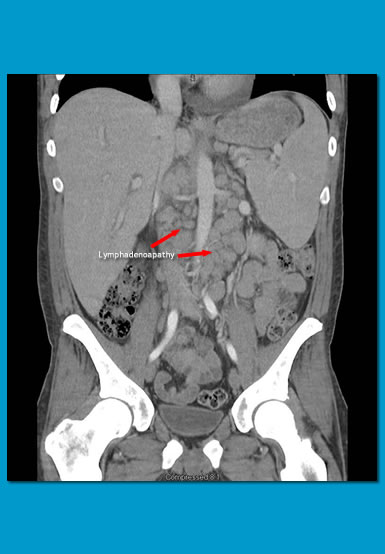Infectious Diseases Case of the Month |
||||||
 |
A thirty-four year old white male heterosexual with HIV/AIDS was admitted to the hospital for hypercalcemia and acute renal failure. AIDS had been diagnosed two months previously when he had presented with diffuse pneumonitis secondary to Pneumocystis jirovecii. At the time of his diagnosis his CD4 count was 22 and HIV viral load was 7,900,000 copies/ml. His respiratory illness responded readily to anti-pneumocystis therapy and prednisone. A rash to TMP/SMX necessitated change to dapsone for secondary prophylaxis of pneumocystis. He was begun on antiviral therapy of HIV with Atripla (tenofovir, emtricitabine, efavirenz) and prophylaxis for Mycobacterium avium complex (MAC) with weekly azithromycin. Two or three weeks subsequent to his initial clinical improvement he began to experience headaches. A lumbar puncture was performed with normal results including CSF VDRL, cryptococcal antigen, and cultures for bacteria, fungi, and AFB. A Quantiferon Gold test (gamma interferon release assay) was negative. He then began to experience fevers, malaise, back, and abdominal pain. Eventually, a blood culture was positive for Mycobacterium avium complex. The patient was begun on therapeutic doses of azithromycin, ethambutol, and rifabutin. He developed severe nausea and vomiting and was unable to tolerate his oral medications (except for Atripla) even with the aid of anti-emetics. When his abdominal pain worsened, he presented to the emergency room where he was discovered to be hypercalcemic (CA 14.1) and in renal failure (creatinine 2.1). An abdominal CT scan (see left and click here for larger images) showed extensive lymphadenopathy of the mesentery and retroperitoneum. The patient was admitted to the hospital. At the time of his admission he appeared dehydrated. He had no cutaneous lesions nor abnormal peripheral lymphadenopathy. A CD4 count was 94 (it had been as high as 223 one month earlier). His HIV viral load was 8,350 copies/ml. He was treated for his hypercalcemia and renal failure. Upper GI endoscopy findings were notable for bile gastritis. Therapy with sucralfate eliminated his nausea and vomiting. A biopsy was performed of a retroperitoneal lymph node. |
|||||
|
Answer and commentary will follow submission of your answer. |
|||||